If you’re considering a kitchen renovation, one of the first decisions you’ll need to make is whether to keep your existing cabinets or replace them. If you decide to replace them, should you buy new cabinets or can you move and reuse the ones you have? Here’s a guide to help you answer that question.
How to Move Kitchen Cabinets?
Moving kitchen cabinets is no easy task. It’s better to take extra precautions when it comes to doing so, as you don’t want to risk damaging them and having them break during the process. Here are some steps to follow when moving your kitchen cabinets:
- Make sure all contents in the cabinet have been safely removed. This includes any dishes, food, or other items that may be inside;
- Carefully detach each cabinet from any built-in appliances like fridges and stoves that are connected or close by. This can involve removing screws, connectors, or pipes;
- Remove any hardware from the wall where necessary, such as locks and handles;
- Lift the cabinets with the help of a friend. Make sure to bend at your knees and keep your back straight when lifting;
- If you’re planning on moving the cabinets downstairs, use a hand truck or furniture dolly to make it easier;
- Securely place each cabinet in its new location, making sure they are level and properly aligned with all the other components in your kitchen;
- Reattach any necessary hardware, pipes, screws, etc., to their proper places for greater stability;
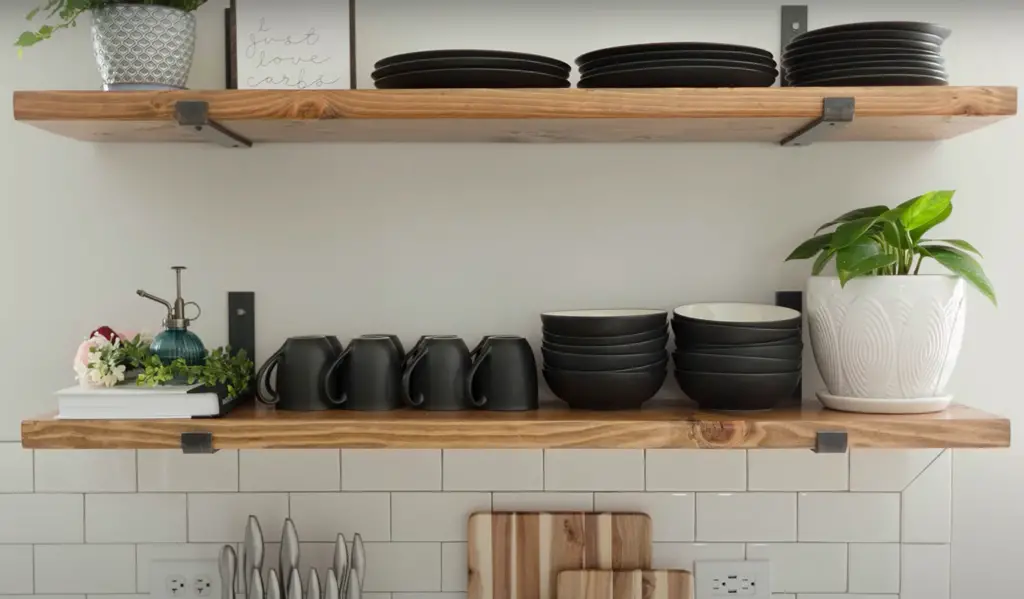
Preparing to Take Out Kitchen Cabinets
Before you decide to move and reuse your kitchen cabinets, take a few minutes to think about the job. You’ll need to properly measure and remove the existing cabinets, as well as devise a plan for safely transporting them to their new location.
Start by measuring the cabinet space where you want to put your cabinets back in. Then, make sure that all of the measurements are consistent with the dimensions of the old cabinets. Once you have this information, you can begin taking out all of the components like doors and drawers from each cabinet before removing it from its original place.
Be sure to keep track of screws, nails, and other hardware during this process so that they are easily available when needed later on. Additionally, take photos of the cabinets during the removal process so that you have a visual reference in case any confusion arises.
Finally, it’s important to consider how you will transport the kitchen cabinets. Make sure that your vehicle or trailer is large enough to comfortably fit all of them and plan out the route you will take to get them from one place to the other. If you’re moving them over a long distance, it would be best to rent a professional moving truck that can handle the weight of all your cabinets.
Removing Cabinets to Reuse
Now that you’ve prepared to move your cabinets and have a plan, it is time to actually remove them. Before doing so, make sure to turn off the power to any electrical components associated with the kitchen cabinet so that no one gets hurt during the process.
Once done, begin removing each component from the cabinet structure one by one. Label each part with a marker or permanent marker to ensure that you can easily reassemble it in the future. To ensure that the cabinets are not damaged during the removal process, make sure to use furniture blankets, and straps for extra protection.
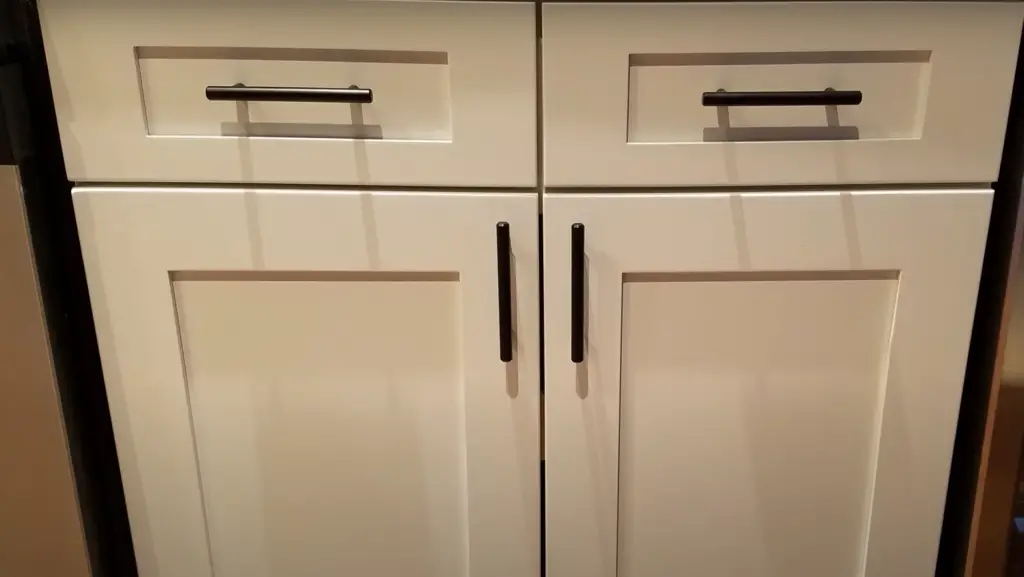
Once you have all of your kitchen cabinet components removed and labeled, disassemble the cabinet structure itself. Be sure to save all screws, hinges, and other hardware that you have taken out so that they can be reused later on.
Prepare Walls for Cabinet Reconfiguration
Now that you’ve successfully removed all of the cabinets, it is time to reconfigure them in their new space. Before doing so, make sure to check your walls for any structural damage or irregularities that may have occurred during the removal process.
Also, if needed, try and patch up any holes or cracks in the wall that may have been created during cabinet removal. This will help ensure that the cabinets are securely and properly installed in their new space.
Finally, make sure to thoroughly clean all of the walls, shelves, and cabinets before putting them back into place. This will help reduce dust and dirt build-up when they are reassembled in their new location.
Rearranging Existing Kitchen Cabinets
Now that you have everything cleaned up and the walls prepped for installation, it is time to start putting your kitchen cabinets back together. Be sure to follow the original plans that you took pictures of or saved so that all components are placed in their proper positions.
Reattach all of the doors, drawers, shelves, and other parts before putting them into place. Additionally, make sure to use new screws and any previously saved hardware when reattaching items like hinges and locks. If needed, purchase additional wood glue or another type of adhesive to ensure that all parts stay secure.
Once done, sit back and admire your work! With careful planning and preparation, you can successfully move and reuse existing kitchen cabinets with ease.
Installing Kitchen Cabinets
If you are looking to install your kitchen cabinets in an entirely new space, there are a few extra steps that must be taken. Begin by measuring the area so that you can purchase the appropriate size of cabinets for the space.
Additionally, you may want to take some pictures of the layout and design ideas for the kitchen. This will help ensure that all components are placed correctly for maximum efficiency and storage capabilities. [1]
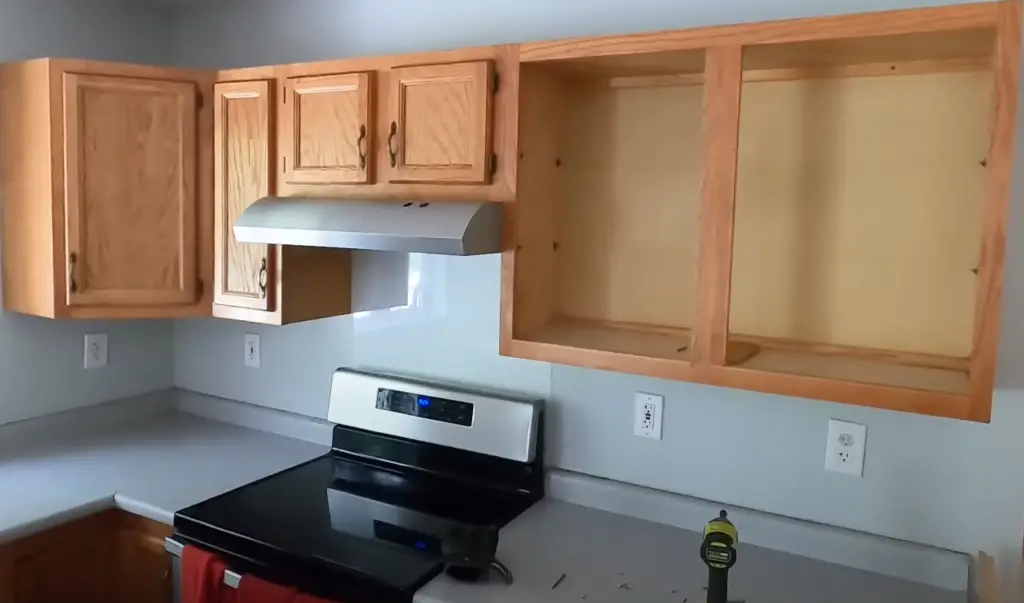
Once purchased, begin installing each kitchen cabinet into its designated place starting with the bottom ones first. Use screws or nails to securely attach them to studs in the wall if possible. If not, use heavy-duty mounting tape or adhesive strips as an alternative option. Finally, reattach all of the doors, drawers, and shelves to their respective cabinets.
Reasons to Try Reusing Kitchen Cabinets
Reusing kitchen cabinets is a great way to save money and reduce the environmental impact of your remodel. There are several advantages to reusing existing cabinets:
- Cost Savings – Reusing existing cabinets can save you up to 50% off the cost of buying new ones. Not only that, but it might make sense financially if you’re able to move them from one part of the home to another without having to get rid of them or pay for expensive installation fees;
- Easy Installation – Installing used kitchen cabinets is usually easier than installing brand-new ones because they are already cut and designed for your space. This means that there’s less prep work involved in making sure everything fits correctly when you move them into your new kitchen;
- Low-Impact on the Environment – Reusing cabinets is a great way to reduce the amount of waste associated with remodeling projects, as it helps keep materials out of landfills. Plus, if you’re able to find cabinets that are made from renewable or recycled materials, even better;
- Personalization Options – Another benefit of reusing kitchen cabinets is that you can customize them however you like. You can paint over existing finishes and add new hardware to give them a fresh look or update their style to match the rest of your space [2];
Reusing existing kitchen cabinets is an easy and cost-effective way to upgrade your kitchen without having to purchase all new materials. With a little bit of work, you can move and reuse your cabinets with ease!
How to Reuse Kitchen Cabinets
If you’re looking to reuse or repurpose your existing kitchen cabinets, there are plenty of ways to give them a fresh new look. Painting is one option that can dramatically change the feel of your kitchen, especially if you choose a bright color like yellow or teal. You can also add molding and decorative accents for an even more unique touch. Or, if you’d rather keep it simple and minimize any potential messes, consider refinishing with stain or varnish instead.
Whatever route you choose, be sure to properly clean and sand the cabinets beforehand. This will ensure that whatever finish you decide on will stick and give your cabinets the best chance of looking good for years to come.
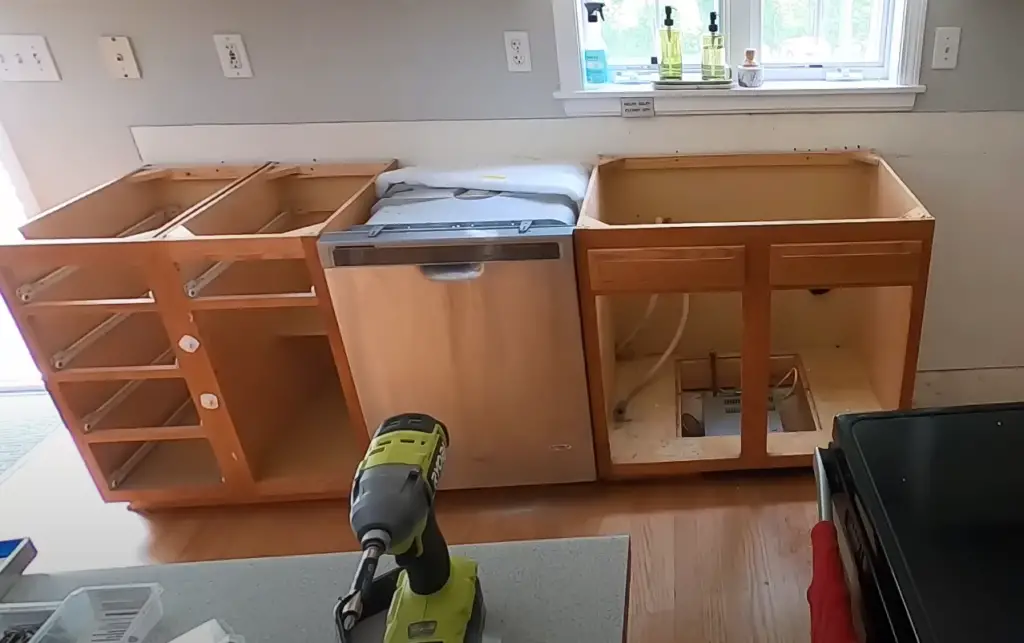
Some Useful Tips
Before you start your kitchen cabinet moving project, it’s important to have a plan in place. Make sure you know exactly what cabinets you have and which ones are going where. If possible, try to measure the space that they need to fit into so that there won’t be any surprises when it comes time for installation.
You should also take into consideration the type of material used for the cabinets. Some may require extra care when being moved because of their delicate nature or size. It is always a good idea to hire professionals if needed or leverage friends and family who can help with lifting and transportation.
Before reinstalling the cabinets, make sure to give them a thorough cleaning with some mild soap and water. This will help to sanitize them and make sure that any dirt, grease, or grime is removed.
It’s also a good idea to inspect the cabinets for any damage or wear and tear before reinstalling them. Check for things like peeling paint, broken parts, or cracked laminate. If anything needs to be repaired, it should be done before reinstalling the cabinets.
Depending on how you plan on moving your kitchen cabinets and if they need to fit into different spaces, you may want to consider taking them apart prior to moving them. This can make transportation easier and ensure that all pieces are accounted for when reassembling the cabinet after installation is complete.
FAQ
Can kitchen cabinets be removed and reinstalled?
Yes, kitchen cabinets can be removed and reinstalled. The process typically involves removing all of the hardware such as hinges and handles, then unscrewing the cabinet from the wall and floor. Once it’s been taken down, you can transport it to its new location and reattach it with relative ease. However, if you plan on moving your cabinets across state lines or over a long distance, it is best to hire professional movers for this task. [3]
Can kitchen cabinets be relocated?
Yes, it is possible to relocate kitchen cabinets. Whether you’re moving them from one room in your home to another or taking them with you to a new residence, there are several factors to consider before embarking on any removal and relocation project.
Before attempting to move the cabinets, make sure that you have all the necessary tools for the job including a screwdriver, drill, and screws. It’s also important to check whether your kitchen cabinets can be easily disassembled – many models come apart quite easily while some others may require more time and effort. Once they’ve been safely taken apart, it would be wise to label each piece so that it’s easier to put them back together at their new destination.
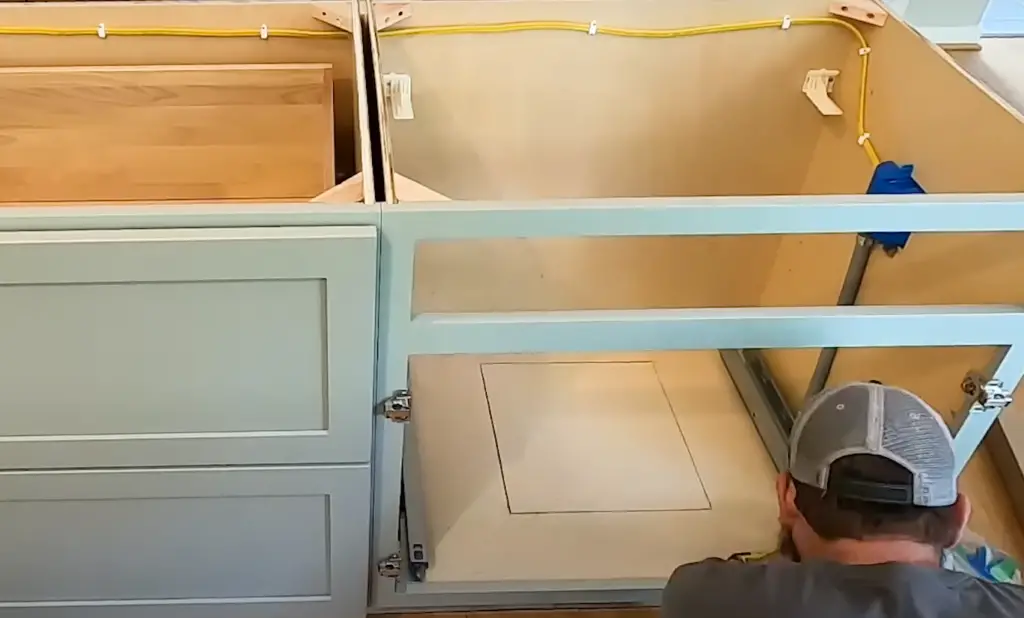
Once you’ve successfully relocated your kitchen cabinets, it’s time to reassemble them in their new home! Referring back to those labels will be extremely helpful. Don’t forget to double-check the placement of all pieces, tighten screws and ensure that everything is firmly bolted in place before you finish up.
Can I reuse my kitchen cabinets?
Yes, you can reuse kitchen cabinets in many cases. Moving and reinstalling them properly is the key to success. As long as the cabinets are still structurally sound and have all their parts intact, they’re often capable of being reused after moving them to a new home or location. [5]
There are some factors that should be considered before attempting to move kitchen cabinets: size, weight, condition, type of material used in construction, and age. Cabinets made out of solid wood will likely be more durable than those made from particleboard or other composite materials. And if the cabinets being moved are particularly large or heavy, it may be necessary to hire professional movers in order to safely relocate them properly.
Can you take out kitchen cabinets without destroying them?
Yes, it is possible to remove kitchen cabinets without damaging them. Before starting the removal process, there are a few precautions you should take in order to preserve the cabinets as much as possible. First and foremost, make sure to turn off the power and water supply before you begin. Then, make sure that all fixtures such as sinks and countertops are detached from the cabinet frames. Once these steps have been taken, carefully unscrew any hinges and knobs connected to the cabinets. Finally, use a flathead screwdriver or another tool to gently pry open each cabinet door starting from one side while pushing towards the opposite side until they come free of their frame. With some patience and care, you can successfully remove your kitchen cabinets without causing too much damage.
Useful Video: Kitchen Remodel Ideas YOU DIDN’T THINK OF YOURSELF!
Conclusion
When it comes to moving or reusing kitchen cabinets, you can take on the task yourself if you’re up for a challenge! However, we recommend leaving this type of project to a professional. They will be able to remove your current cabinets and properly install your new ones in no time. Additionally, they’ll know how best to handle any issues that may arise like damage or warping along the way. Moving or reusing kitchen cabinets is definitely possible but don’t underestimate the complexity of this job. It’s always better to get help from an experienced pro so that your kitchen looks perfect when all is said and done. With the helpful tips above and some patience, you’ll have all the information you need to decide if you can move and reuse your kitchen cabinets. Good luck!
References:
- https://www.hunker.com/12002033/how-to-move-kitchen-cabinets
- https://lehmanlane.net/reworking-kitchen-cabinets-get-kitchen-layout-want/
- https://www.budgetdumpster.com/blog/how-to-remove-kitchen-cabinets/
- https://www.angi.com/articles/moving-cabinets.htm
- https://www.familyhandyman.com/list/8-ways-to-reuse-your-old-kitchen-cabinets/





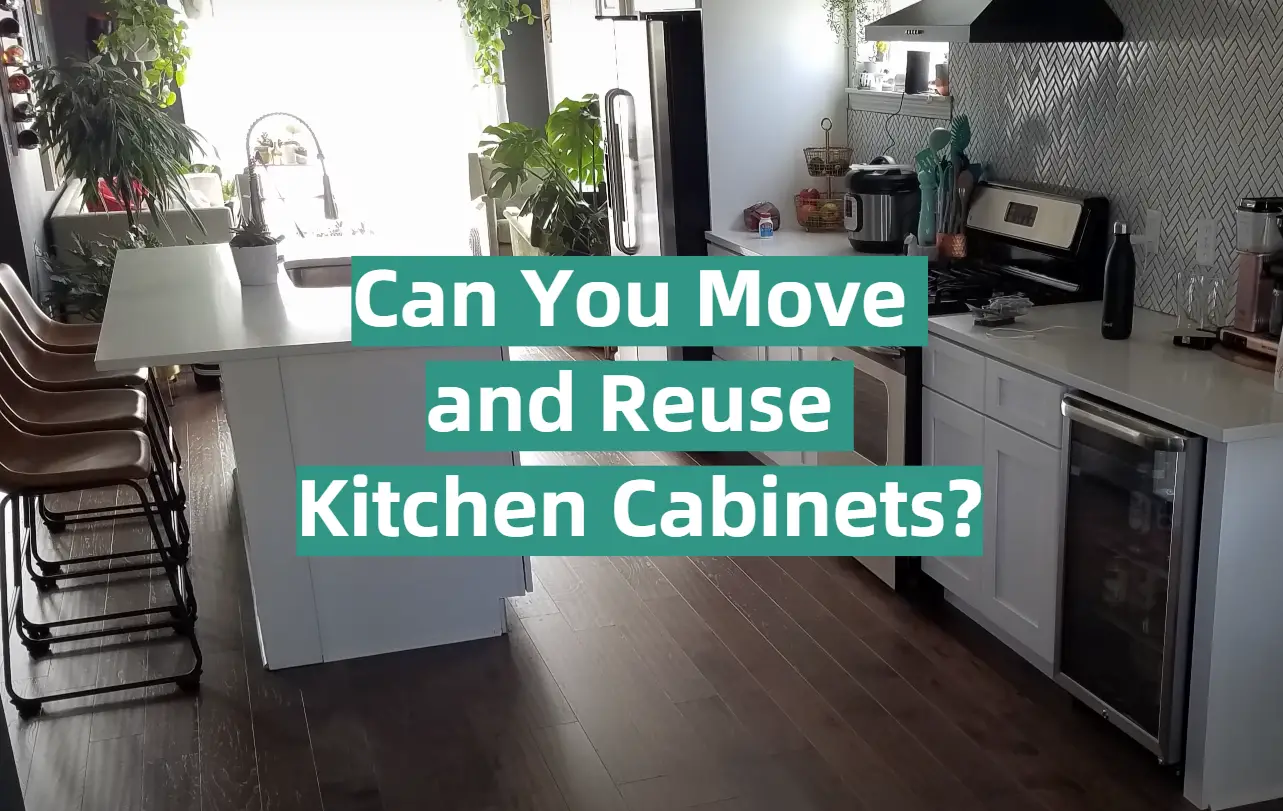





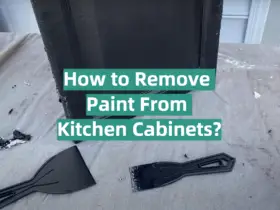
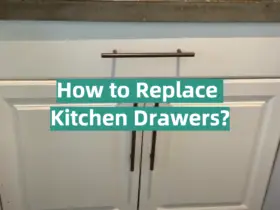

When we moved into our new home, the kitchen layout just didn’t work for our family. We decided to try moving some of the existing cabinets around to create a better workflow before committing to an expensive remodel. I was pleasantly surprised by how easy it was to detach, move, and reinstall the cabinets! As long as you have some basic DIY skills, moving kitchen cabinets is very doable. You may need to patch a few holes and repaint, but rearranging cabinets can give your kitchen a whole new look on a budget.
I’ve moved with my kitchen cabinets twice now, and both times I was able to disassemble, transport, and reinstall them in the new home. As long as your cabinets are in good condition, it is absolutely possible to move them to a new home and save a lot of money in the process. The key things to keep in mind are removing doors and drawers, detaching them from walls carefully to avoid damage, and numbering pieces so reassembly is easier. It takes some work, but being able to reuse quality cabinets makes it well worth the effort in my opinion.
When we relocated, I was thrilled to learn that our beautiful custom kitchen cabinets could make the move with us. My husband was able to remove them without damage by unscrewing them from the walls and lifting them off the braces. Numbering each cabinet and door made reinstalling them very straightforward. We saved thousands of dollars by moving our cabinets! The only additional work required was patching some drywall holes and giving the cabinets a fresh coat of paint.
I like to renovate and remodel my home myself, so I was excited to try moving some kitchen cabinets around to create a better layout. Detaching the cabinets was easier than expected – a cordless drill with various driver bits enabled me to remove the screws and lift them off the wall mounts. Moving the cabinets into place was cumbersome but doable with an extra set of hands. Reattaching to the wall went smoothly. I’m so pleased I could rearrange my kitchen on a limited budget by reusing my existing cabinets.
When we were thinking of renovating our kitchen, a contractor suggested rearranging our cabinets rather than replacing them. I was skeptical at first, but he assured me that removing, moving and reinstalling the cabinets was totally doable. We labeled each cabinet and drawer to keep things organized. The contractor detached them from the walls and the ceiling braces, making sure not to damage the cabinets. After reconfiguring the layout, he reattached them in the new arrangement. I’m so glad we were able to give our kitchen a fresh new look by rearranging the cabinets rather than spending on new ones.
My wife and I recently decided to reconfigure our kitchen layout to make better use of the space. I was concerned about the challenge of moving the existing cabinets, but found many online tutorials assuring me it could be done. I took care to detach the cabinets without damage and labeled pieces for easy reassembly. Moving the large cabinets required help, but went smoothly. Minor repairs were needed but overall, we successfully achieved a new kitchen layout while saving thousands by reusing the existing cabinets. I’m proud of our DIY project and happy we didn’t need to replace our good quality cabinets.
When we moved, instead of buying all new kitchen cabinets I explored moving our existing ones to save money. After watching some online videos I felt confident I could detach them without damage and reinstall in our new home. It was somewhat tedious labeling each cabinet and keeping hardware organized, but with time and care I was able to disconnect them, transport without issue, and rehang in our new kitchen. A few needed minor repairs but in the end it worked out wonderfully. Reusing cabinets saved a bundle and prevented good cabinets from ending up in a landfill.
We felt our small galley kitchen wasn’t functioning efficiently, but couldn’t afford a full remodel. When a contractor suggested rearranging the cabinets, I did some research and realized it was possible. He systematically detached each one, taking care not to damage them or the walls. We came up with an improved layout and he was able to beautifully reinstall the cabinets in the new configuration. Because the cabinets were high quality and in great shape, reusing them saved us thousands of dollars and still gave us the refreshed look we wanted.
When we bought a house with an awkward kitchen layout, I looked into our options. Custom cabinets were out of our budget. Then I learned existing cabinets could be removed and reinstalled in a better configuration. We labeled each cabinet and door to keep organized. I had some repair work after moving them, but was able to do the patch, sanding and paint myself over a weekend. Our “new” rearranged kitchen looks amazing. Reusing cabinets allowed us to improve the space on a tight budget. I’m so glad we didn’t have to buy all new.
My kitchen cabinets were good quality but the layout was inefficient. I cringed at the cost of new custom cabinets. Then I realized I could probably move the existing cabinets myself. I watched tutorials to learn the techniques for removing them without damage and transporting safely. It took time but with care I was able to disconnect, rearrange and reinstall the cabinets to create a much improved working kitchen. Some repairs were needed but overall it went smoothly. I’m thrilled that reconfiguring the cabinets gave me a fresh new look at a fraction of replacement cost.
We wanted to change the awkward angles in our outdated galley kitchen but thought we’d need all new cabinets. Our contractor suggested keeping the well-built existing cabinets and rearranging them. He systematically labeled and detached them and proposed a better layout utilizing those cabinets. After reinstalling them it really opened up the kitchen! We updated the hardware for a modern look. I’m so glad we could transform the kitchen in a cost-effective way by reusing cabinets that were in excellent condition.
When our kitchen remodel revealed a poorly planned, dysfunctional layout, I assumed new custom cabinets were our only option. On a whim, I got a quote to move the existing cabinets into an improved arrangement and was pleasantly surprised how reasonable it was compared to full replacement. The contractor was able to detach, relocate and rehang the cabinets with relatively minimal repairs needed. Reusing quality cabinets saved thousands and prevented materials from needlessly ending up in a landfill. I’m thrilled our reimagined kitchen was so economical thanks to cabinet rearrangement.